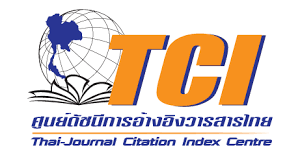The Development of a Physical Environment Assessment Form for Safety and Security in Transitional Space between Mass Transit Stations and Buildings
- Thapanee Panpet, Multidisciplinary Design Research Program, School of Architecture, Art and Design, King Mongkut’s Institute of Technology Ladkrabang, Bangkok 10520, Thailand, *Corresponding author, E-mail: 60602002@kmitl.ac.th
- Yanin Rugwongwan, School of Architecture, Art and Design, King Mongkut’s Institute of Technology Ladkrabang, Bangkok 10520, Thailand
Abstract
Mass transit systems are vital in addressing traffic congestion and promoting the economy in the city and surrounding spaces. The transitional space connecting mass transit stations and buildings holds significance as it improves accessibility and convenience, especially along transit routes, with a focus on those serviced by electric train lines. The primary objective of travel is to reach one's destination safely and efficiently. This research aims to investigate the criteria and develop assessment forms for assessing the physical environment for safety and security in transitional spaces between mass transit stations and buildings. This qualitative research studies and filters criteria from regulations, laws, and theories related to the physical environment for safety and security. First, developing an assessment designed for an initial trial in the specific area. Next, ensuring the tool’s compliance through an expert evaluation. Subsequently, conducting a second trial within the area to identify and implement any necessary improvements, with a final validation carried out by an expert. Only after all necessary corrections have been made and verified will this assessment be utilized in subsequent evaluations. The research found that the central concept of the assessment model focuses on good visibility throughout the journey, the lack of obstacles that can cause danger, and the importance of safety equipment and personnel readiness. The assessment consists of two main factors, seven sub-factors, and 46 criteria, including (1) the physical environment factor for safety and security consisting of boundaries, entrances, and positioning of transitional spaces (12 items), blind corners and obstacles (10 items), lighting (2 items), signs and information (7 items), cleanliness and maintenance (3 items), (2) the security equipment and security guard factor, consisting of safety equipment (6 items), and security guard (6 items) in maintaining a secure environment.
Keywords: Assessment form, Transitional Space, Physical Environment, Safety and Security
DOI: 10.14456/jcsh.2024.7
References
Alexander, K. (1993). Developing facilities for competitive advantage. University of Strathclyde, Centrefor Facilities Management.
American Public Transportation Association. (2010). APTA Standards Development Program Recommended Practice Crime Prevention Through Environmental Design (CPTED) for Transit Facilities. Washington, DC, U.S.A. Retrieved from https://www.apta.com/wp-content/uploads/Standards_Documents/APTA-SS-SIS-RP-007-10.pdf
Badiora, A. I., Wojuade, C. A., & Adeyemi, A. S. (2020). Personal safety and improvements concerns in public places: An exploration of rail transport users’ perception. Journal of Place Management and Development, 13(3), 319-346. https://doi.org/10.1108/JPMD-03-2019-0013
Benn, S. I., & Gaus, G. F. (1983). Public and private in social life. New York, US: St. Martin's Press.
BIFM. (2003), Rethinking FM, London, UK: BIFM Press Release.
Bowes, D. R., & Ihlanfeldt, K. R. (2001). Identifying the impacts of rail transit stations on residential property values. Journal of Urban Economics, 50(1), 1-25. https://doi.org/10.1006/juec.2001.2214
Ceccato, V., & Newton, A. (2015). Safety and Security in Transit Environments. An Interdisciplinary Approach. England, UK: Macmillan Distribution Ltd.
Ceccato, V., Gaudelet, N., & Graf, G. (2022). Crime and safety in transit environments: a systematic review of the English and the French literature, 1970–2020. Public Transport, 14(1), 105-153. https://doi.org/10.1007/s12469-021-00265-1
Chotipanich, S. (2010). Facility Management: Principles and Theories. Bangkok, Thailand: The Chulalongkorn University Press.
Cozens, P., & Love, T. (2015). A Review and Current Status of Crime Prevention through Environmental Design (CPTED). Journal of Planning Literature, 30(4), 393–412. https://doi.org/10.1177/0885412215595440
Cozens, P., Love, T., & Davern, B. (2019). Geographical Juxtaposition: A New Direction in CPTED. Social Sciences, 8(9), Article 252. https://doi.org/10.3390/socsci8090252
Deniz, D. (2018). Improving Perceived Safety in Public Transportation Through Design. Southampton, UK: WIT Press. https://doi.org/10.2495/UT180191
Guthrie, A., & Fan, Y. (2016). Developers’ perspectives on transit-oriented development. Transport Policy, 51, 103–114. https://doi.org/10.1016/j.tranpol.2016.04.002
Jeffres, L. W., Bracken, C. C., Jian, G., & Casey, M. F. (2009). The Impact of Third Places on Community Quality of Life. Applied Research in Quality of Life, 4(4), 333–345. https://doi.org/10.1007/s11482-009-9084-8
Julasai, B., & Chotipanich, S. (2004). Facility Management. Bangkok, Thailand: The Chulalongkorn University Press.
Maslow, A.H. (1954). Motivation and personality, New York, US: Harper & Brothers.
Mihinjac, M., & Saville, G. (2019). Third-Generation Crime Prevention Through Environmental Design (CPTED). Social Sciences, 8(6), 182. https://doi.org/10.3390/socsci8060182
Ministry of Justice: New Zealand. (2005). National Guidelines for Crime Prevention through Environmental Design in New Zealand Part 1: Seven Qualities of Safer Places. Retrieved from website https://www.justice.govt.nz/assets/cpted-part-1.pdf
Muanhong, A. (2016). Security Management in Shopping Mall: A Case Study of Six Shopping Mall in Central Business of Bangkok (Master’s thesis). Chulalongkorn University. Bangkok, Thailand.
Newman, O. (1977). Defensible space: people and design in the violent city. London, UK: Architectural Press.
Newton, A. (2018). Macro-Level Generators of Crime, Including Parks, Stadiums, and Transit Stations. In Gerben J. N. Bruinsma., & Shane D. Johnson (Ed.), The Oxford Handbook of Environmental Criminology, (pp. 497–517). New York, US: Oxford University Press.
Nutt, B. (2004). Infrastructure resources: forging alignments between supply and demand, Facilities, 22(13/14), 335-343. https://doi.org/10.1108/02632770410563031
Office of Transport and Traffic Policy and Planning. (2020). Organized a seminar to listen to opinions for the 3rd time. Study on the preparation of TIA traffic impact analysis standards. Retrieved from https://www.otp.go.th/post/view/3275
Panpet, T., & Upala, P. (2020). Laws and Regulations for Designing Physical Environment and Safety of Transitional Areas between Mass Transit Stations and Buildings. Proceedings of the 13th ATRANS (Asian Transportation Research Society) Symposium, Bangkok, Thailand.
Randall, I, A. (2008). 21st Century Security and CPTED Designing for Critical Infrastructure Protection and Crime Prevention (2nd ed.). New York, US: Harper & Brothers.
Royal Thai Government Gazette. (1999a). Ministerial Regulation No. 4 (B.E. 2542) was issued under Empowerment of Persons with Disabilities. Act, B.E. 2534. Retrieved from http://web1.dep.go.th/sites/default/files/files/law/45.pdf
Royal Thai Government Gazette. (1999b). Regulations of the Rehabilitation Committee for the Disabled-on control Standards for equipment and facilities directly to people with disabilities, B.E. 2544. Retrieved from https://dl.parliament.go.th/handle/20.500.13072/284241
Royal Thai Government Gazette. (2000). Mass Rapid Transit Authority of Thailand Act (MRTA), B.E. 2543. Retrieved from https://www.mrta.co.th/en/act/14466
Royal Thai Government Gazette. (2001). Bangkok ordinance on Building Control Act B.E. 2544. Retrieved from https://webportal.bangkok.go.th/upload/user/00000075/about_us/O6/Tedsakij/Legis_BKK_Building_2544.pdf
Royal Thai Government Gazette. (2012). Announcement of Bangkok Metropolis Re: Criteria for Permission and Compensation for Construction of Links Between Transportation Systems Bangkok Mass Extension with outside buildings. Retrieved from https://info.dpt.go.th/app-service/wan/lawdpt/data/02/2559/129_187g_131255.pdf
Royal Thai Government Gazette. (2021). Ministerial Regulation Prescribing the Facilities in the Building for Disabled, and Old Persons (No. 4) B.E. 2564. Retrieved from https://download.asa.or.th/03media/04law/cba/mr/mr64(02)-68c.pdf
Samboonraung, D. (2010). Managing of Security in Shopping Malls Located in The Pathumwan Area: Three Case Studies (Master’s thesis). Chulalongkorn University, Bangkok, Thailand.
Sundling, C., & Ceccato, V. (2022). The impact of rail-based stations on passengers’ safety perceptions. A systematic review of international evidence. Transportation Research Part F: Traffic Psychology and Behaviour, 86, 99-120. https://doi.org/10.1016/j.trf.2022.02.011
The National Crime Prevention Council (NCPC) of Singapore. (2003). Crime Prevention Through Environment Design Guidebook. Retrieved from https://appdev.ifdemo.com/ncpcorgsg/images/media/CPTED.pdf
The Queensland Government. (2021). Crime Prevention through Environmental Design guidelines for Queensland. Retrieved from https://www.police.qld.gov.au/sites/default/files/2021-07/Crime%20Prevention%20Through%20Environmental%20Design%20-%20Guidelines%20for%20Queensland%202021%20v1.pdf
Thongmar, T. (2015). Development of Standard Criteria for Risk Assessment in Facility Management Office Building (Master’s thesis). Silpakorn University, Bangkok, Thailand.
Welsh, B. C., Mudge, M. E., & Farrington, D. P. (2009). Reconceptualizing public area surveillance and crime prevention: Security guards, place managers and defensible space. Security Journal, 23(4), 299–319. https://doi.org/10.1057/sj.2008.22
Zhong, H., & Li, W. (2016). Rail transit investment and property values: An old tale retold. Transport Policy, 51, 33–48. https://doi.org/10.1016/j.tranpol.2016.05.007

Indexed in


Search